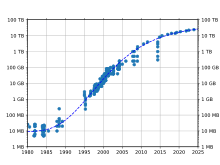User:Ruud Koot/Hard disk drive
Capacity[edit]

Capacity measurements[edit]
Hard disk manufacturers quote disk capacity in multiples of SI-standard powers of 1000, where a terabyte is 1000 gigabytes and a gigabyte is 1000 megabytes.[1] Many operating systems and utilities – including Microsoft Windows and Apple's MacOS X prior to version 10.6 – report hard disk capacity in powers of 1024, where a terabyte is 1024 gigabytes and a gigabyte is 1024 megabytes. Therefore available space appears less than advertised capacity. The relative difference between the two capacity measurements increases logarithmically with the capacity of the hard disk. The actual number for a formatted capacity will be somewhat smaller still, depending on the file system.
The discrepancy between the two methods of reporting sizes had financial consequences for at least two hard drive manufacturers when a class action suit argued the different methods effectively misled consumers (see Orin Safier v. Western Digital Corporation and Cho v. Seagate Technology (US) Holdings, Inc.).[2][3]
Starting in about 1998, a number of standards and trade organizations approved standards and recommendations for a new set of binary prefixes, proposed earlier by the International Electrotechnical Commission (IEC), that would refer unambiguously to powers of 1024. According to these, the SI prefixes would only be used in the decimal sense, even when referring to data storage capacities. As of 2011 they have seen little adoption in the computer industry. Microsoft Windows continues to reports disk and file sizes using customary binary prefixes, while Apple's MacOS X switched to decimal prefixes in version 10.6,[4] with Ubuntu planning to do so as well.[5]
| Source | Advertised capacity by manufacturer |
Expected capacity by consumers in class action suit |
Reported capacity | Formatted capacity | ||||||
|---|---|---|---|---|---|---|---|---|---|---|
| Windows | Mac OS X 10.6 | NTFS | HFS+ | ext3 | ||||||
| Units | Decimal prefixes | Bytes | Binary prefixes | Bytes | Difference | Binary prefixes | Decimal prefixes | Decimal prefixes | ||
| 100 MB | 100000000 | 100 MB | 104857600 | 4.36% | 95.37 MB | 100 MB | (todo) | |||
| 100 GB | 100000000000 | 100 GB | 107374182400 | 6.87% | 93.13 GB 95367.40 MB |
100 GB | ||||
| 100 TB | 100000000000000 | 100 TB | 109951162777600 | 9.05% | 90.95 TB 93132.30 GB 95367431.64 MB |
100 TB | ||||
Notes[edit]
- ^ i.e. see HGST, Samsung, Seagate, Toshiba and Western Digital websites
- ^ http://www.foxnews.com/story/0,2933,201269,00.html Western Digital Settles Hard-Drive Capacity Lawsuit, Associated Press June 28, 2006 retrieved 2010 Nov 25
- ^ Seagate lawsuit concludes, settlement announced, bit-tech.net
- ^ http://support.apple.com/kb/TS2419
- ^ https://wiki.ubuntu.com/UnitsPolicy
References[edit]
- Mueller, Scott (2011). Upgrading and Repairing PCs (20th ed.). Que. ISBN 978-0789747105.
- Messmer, Hans-Peter (2001). The Indispensable PC Hardware Book (4th ed.). Addison-Wesley. ISBN 0201596164.
